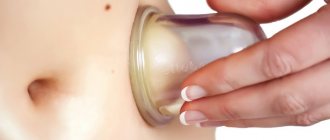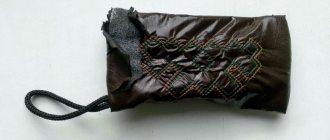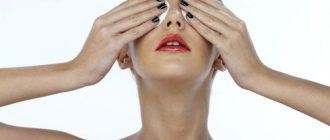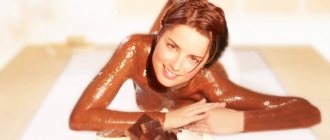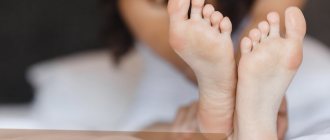I just want to add a phrase here to give it to lovers of fashionable wallets.
Yes, it’s true, the snake takes off its own skin, and if anyone has ever observed this in nature, they will say that the process of getting rid of old skin from a snake is like something out of a horror movie.
Wriggling, she tears her own skin near her mouth and on her head, inflicting wounds on herself, then with her torn skin she clings to some twig or sharp stone and crawls out of her skin, leaving it turned inside out, as if it were a child’s stocking.
At the same time, the snake wriggles in such a way that it seems to the uninitiated viewer that it is experiencing unbearable pain. We don’t know whether a snake shedding its skin feels pain, most likely not, skin replacement is a natural physiological process, compare molting in animals, nature probably saved the snake from unpleasant sensations.
So why do snakes perform this terrible ritual on themselves? That's the whole point. that the snake is growing, and its skin is like clothing, it becomes tight for it
. It rubs and wears from crawling on the ground, protecting the snake's delicate body from wounds as it crawls. New skin grows under the old skin and therefore the snake sheds it.
At a young age, snakes grow quickly, which means they are more often forced to get rid of the old skin that has become tight to them. And let animal lovers not be angry, the snake itself gives leather for wallets to lovers of all things extravagant. Is not it .
PS Just for fun
- My dear, give me money for peeling!
- What is peeling?
- This is when you remove the old skin, and underneath it there is a new one - smooth and beautiful!
- And I always thought that you snakes shed for free!
They say that the biblical serpent was very sorry when he tempted Adam and Eve with an apple.
- Why?
- After Eve took a bite of the apple, she saw in the Snake not only an animal, but also a belt, a wallet and a handbag.
Today, many lovers of exotic animals keep snakes as pets. Such a pet requires the owner to have some knowledge about the pet’s lifestyle and life cycle, for example, about the molting process. What reasons prompt reptiles to shed their skin and how this happens - we’ll talk in this article.
How to prepare for dropping
Reptiles, sensing the approaching molting process, try to get enough first. This is necessary because shedding the skin takes a long time and a lot of energy. The reptile cannot hunt during preparation and molting itself: it sees and smells poorly, experiences weakness, and has no appetite.
This condition makes the animal extremely vulnerable to natural enemies, so it tries to find a secluded place while peeling.
Depending on the species, reptiles can be dangerous, aggressive and attack anything that seems a threat to them. This applies most of all to poisonous species.
Stages of physiological preparation for skin shedding:
- Within 2–4 days, the scutes on the belly turn pale.
- In about 5–7 days, the mucous membrane of the eye becomes cloudy, turning a milky bluish color. During this period, vision declines significantly.
- The eyes gradually become clearer.
- The pallor of the abdominal scutes disappears.
The entire preparation process takes about 12 days.
Then comes the peeling itself. Did you know?
Based on the found intact old reptile skin and the pattern of scales, one can easily determine what species of snake it belonged to.
Treatment of dryness
Before starting treatment for epidermal dehydration, you should consult a dermatologist. His task is to determine the cause of the problem and prescribe medications that can treat dry heels. If malfunctions in the functioning of internal organs are detected, the patient is referred for consultation to a specialized specialist.
If the causes of dehydration lie in insufficient care of the feet, then the only thing that needs to be done is to regularly care for the feet and use targeted pharmaceuticals.
In any pharmacy you can find drugs to treat dry skin on the heels. They combine components that have a moisturizing, nourishing, softening, wound-healing, anti-inflammatory and regenerating effect.
Pharmacy products
“Sea Wolf” is a foot cream that combines: seaweed extract, juniper extract, formic alcohol, and natural oils. The product moisturizes well, heals cracks, removes discomfort, and accelerates recovery processes. It is equally effective on both women's and men's feet. The cream should be used daily after hygiene procedures.
“Lekar” is a preparation intended for dry skin on the heels, prone to the formation of cracks and hyperkeratosis. Urea, allantoin, vegetable oils and extracts nourish and smooth the epidermis, relieve pain and inflammation, eliminate roughness, and actively moisturize. The cream must be used until the problem disappears completely.
"Bepanten" is a product for external use that helps to quickly cure dry, rough heels. The main active ingredient, dexpanthenol, accelerates the healing process, eliminates pain, and has a softening and moisturizing effect. One of the inherent advantages of Bepanten ointment for dry heels is the possibility of its use during pregnancy and breastfeeding.
Treatment with folk remedies
“Dry heels, what to do?” - a relevant question at any time of the year. Some people prefer to trust medical experience, while others prefer to treat dry heels with traditional medicine recipes.
If we get rid of dry skin on the heels using folk remedies, then the main thing to do is to fight regularly. Heels with a tendency to dryness require systematic care.
Sanding heels correctly using low-abrasive files is also extremely important. The procedure can only be performed on dry skin; movements should be carried out in one direction. To treat wet feet, only pumice, familiar from childhood, is used.
You can remove dryness and flaking at home using popular recipes that are accessible to everyone.
Apple vinegar
A folk remedy proven by more than one generation. To get the desired result, add vinegar (30 ml) to warm water and take a foot bath.
Thanks to the exfoliating effect of acids, the heels become more pliable to further manipulation. Procedure time: 30 minutes. After it, all that remains is to treat your feet with pumice stone, rinse them with cool water and apply a nourishing cream.
Coconut oil
An indispensable remedy in the fight against dryness, flaking and even cracked heels. Use coconut oil for daily evening foot care or add to any foot masks. To enhance the effectiveness, the heels can be wrapped in cling film.
Foot baths
Regular foot baths are the basis for healthy heels. With their help, it is possible to soften the keratinized areas and prepare the feet for subsequent treatment. If the problem is caused by a simple lack of attention to the condition of the feet, then water procedures alone may be enough to completely get rid of unpleasant symptoms.
There are endless recipes for foot baths for dry feet. Let's look at the most effective ones that help cure dry heels in the shortest possible time.
The simplest, but no less effective, are baths with salt and soda. Add ingredients separately or combine them. Salt can be regular table salt or sea salt. Add 1-1.5 tbsp. spoons of the selected component into fairly hot water. Immerse your feet in this solution for half an hour, then polish your heels with a pumice stone, rinse, dry with a towel and apply care cream.
- Medicinal herbs - sage, calendula, chamomile, string - brew with boiling water (3 tablespoons per 1 liter of liquid). Let it brew for 30 minutes, strain.
This bath not only helps to soften rough areas, but also has an anti-inflammatory, wound-healing, and immunostimulating effect.
- An exotic option is a recipe for a red wine bath. To prepare, you will need 150-200 ml of quality wine and a bowl of warm water. Duration of the procedure: 20-25 minutes. After this, you need to cleanse the skin with a pumice stone or scrub, and apply a nourishing cream.
Regular use will help get rid of cracks and peeling on the heels, saturate it with vitamins, and increase tone.
Softening the heels of your feet with masks
There are hundreds of recipes for masks to combat dry heels. Most of them have high nutritional, moisturizing, and anti-inflammatory properties.
- Paraffin mask is an effective remedy for softening heels. Be sure to add 1⁄2 part coconut oil to it. This will enhance the effect. Apply the warm mixture to problem areas in 3 layers. Leave the resulting wax shell overnight. Don't forget to wash off the composition in the morning.
- A honey compress is no less effective. It is extremely simple to implement. Apply honey to your heels and leave for half an hour. Don’t forget to wash your feet afterwards and moisturize them with cream.
Mix lemon juice with olive, castor or melted coconut oil (in a 3:1 ratio). Spread the mixture onto your steamed feet and wait a little less than half an hour. Then the composition should be rinsed off with warm water and a moisturizer should be applied.
Mix aloe juice, boiled oatmeal, honey and castor oil. The composition is applied to the heels for 20-30 minutes. To increase efficiency, you need to cover problem areas with cling film and insulate them.
Take one onion, chop with a blender or using a meat grinder, add a teaspoon of honey, castor oil or sour cream. Mix the ingredients and apply to problem areas. After half an hour, the mixture is washed off with warm water. With the help of a compress, if used regularly, you can cope with the problem of dry skin in 1-2 weeks.
How does she do it
The entire procedure for shedding the old skin takes from half an hour to several hours. As the cells of the new skin divide, the old layer begins to stretch and crack in the muzzle area. The reptile helps him to tear himself apart by rubbing against existing rough surfaces - stones, snags. When the dead layer has opened sufficiently from the side of the head, the reptile begins to wriggle, rub against the roughness, gradually crawling out of the “old clothes”. It is noteworthy that the old layer is turned inside out, like a stocking. Usually the “creep” remains intact, but in very large individuals there may be ruptures.
Important!
If shedding occurs in pieces and not as a whole skin, it means that the animal has health problems and urgently needs to be shown to a doctor.
In the video below you can see how the process of replacing old skin with a new layer occurs.
Video: how a snake sheds its skin
Prevention of lamellar ichthyosis
The main symptom of ichthyosis is a scaly surface of the skin. Other symptoms include: splitting nails, dull and brittle hair, frequent caries, conjunctivitis, retinitis, and myopia.
Vulgar ichthyosis (simple form of ichthyosis). It is the most common form of ichthyosis. Most often observed in newborns under 1 year of age.
Symptoms of vulgar ichthyosis: dry, flaky skin, covered with small scales tightly adjacent to each other, white or grayish. The skin on the feet and palms is folded. In this case, the skin in the following places remains unaffected: armpits, elbow and knee bends, groin and buttocks.
Vulgar ichthyosis has its own subtypes:
- Mild ichthyosis - the skin surface is dry, there is slight peeling of the skin;
- White ichthyosis - small, white, mealy scales;
- Brilliant ichthyosis - the scales look like a mosaic, and the disease spreads mainly to the arms and legs;
- Horny ichthyosis - the scales are very dense and rise above the surface of the skin;
- Serpentine ichthyosis - the horny scutes are dense, separated from each other by grooves;
- Bullous ichthyosis - blisters constantly develop on the skin;
- Lichenoid ichthyosis - in different parts of the scales are located in small localizations, in appearance resembling lichen.
X-linked ichthyosis. It is characterized by large brown scales that fit tightly to the skin, as well as affecting newborns only males. With age and during winter periods, the patient's condition usually worsens.
Linear circumflex ichthyosis. It is characterized by redness surrounded by flaky pink swellings. It looks like dermatitis.
Spiny ichthyosis. Characterized by large spiky layers.
Epidermolytic ichthyosis. It is a severe form of ichthyosis, the main symptoms of which are the formation of blisters and wounds on the skin, which peel off over time, and in their place pathological neoplasms form again. The skin on most affected areas is bright red, while on the palms and soles it is white and thick. At the 3rd and 4th year of a child’s life, concentric ridges form on the skin of his joints.
Ichthyosis of the fetus (Harlequin fetus). The most severe and fatal form of ichthyosis. With this diagnosis, a child dies in the womb, or in the first days/weeks after birth. Symptoms of the Harlequin fetus are very dry, “armor-like” skin, eyelids are turned inside out, ears, mouth and nose are completely deformed, there may be deformation of the head, arms and legs of an irregular shape.
At the moment, an exact treatment regimen for ichthyosis has not been identified, which is due to the fact that the disease itself and its exact etiology (causes of gene mutation) have not yet been fully established. And therefore, treatment of ichthyosis, as of the end of 2020, comes down to maintenance therapy.
- Maintenance therapy for the treatment of ichthyosis includes:
- Maintaining the required level of humidity in the room where the patient is being treated/lives;
- Moisturizing the skin;
- Complete nutrition enriched with vitamins and microelements;
- Strengthening the immune system;
- Treatment of the skin with special products with a healing effect;
- Treatment of concomitant diseases;
- Compliance with preventive measures that are aimed at eliminating already known factors that can cause or aggravate the course of ichthyosis.
Skin hydration
Dry skin with ichthyosis tends to crack. In places of cracking, liquid begins to ooze, and the damaged area begins to hurt. In addition, in places of “break”, the cracks are deep enough for various infections to get into them, and aggravate the course of the disease.
To prevent this, the skin is constantly moisturized. This, firstly, helps to soften keratinized tissue, i.e. giving them relative elasticity. Secondly, a more or less softened surface minimizes cracking of the skin, and, accordingly, the general soreness of the affected areas.
To soften the skin, it is treated several times a day with special products, which are best applied to the skin after water procedures.
Water procedures have proven themselves well, in the form of taking baths with sea salt, a weak solution of potassium permanganate (potassium permanganate), and carbon dioxide baths. At resorts specializing in the treatment of skin diseases, for ichthyosis, applications based on silt, peat and mineral mud are applied to the skin. Such applications help not only moisturize the skin, but also nourish, cleanse, heal and normalize metabolic processes.
To moisturize the skin, you can use products based on petroleum jelly, lanolin, vitamins (especially A, E and F), vegetable oils, almond oil, naphthalan, urea, salicylic acid, etc. These products moisturize and nourish the skin, promote its healing, separation of the upper layer of keratinized dead cells/scales.
To make the effect last longer, it is advisable to humidify the air in the room where the patient is located. To humidify the air, you can use a humidifier.
Important! Since the skin with ichthyosis is already dry and needs to be moisturized, do not allow it to dry out further. This can be caused by products such as soaps and detergents. To care for your body if you have ichthyosis, try to use special moisturizers - soaps, gels and shampoos.
Keratolytic therapy is used to remove dead scales from the surface of the skin.
Keratolytic therapy involves treating the surface of the skin with special products (creams, ointments) that soften dead epidermal cells, after which they are easier to remove.
Products designed to remove dead cells usually contain the following ingredients: salicylic and lactic acids, urea, boric petrolatum, propylene glycol, ethanol, extracts of medicinal plants, for example, Japanese Sophora.
To improve the overall condition of the skin, as well as speed up its healing, sunbathing has a beneficial effect, which provides the surface of the skin with vitamin D (calciferol). However, overheating in the sun is strictly prohibited, otherwise sunburn will only worsen the situation.
To speed up the healing and renewal of the skin, as well as for other skin diseases, it is necessary to focus on additional intake of the following vitamins and microelements: vitamin A (retinol), vitamins B, C (ascorbic acid), E (tocopherol), PP (vitamin B3 , nicotinic acid), iron.
Among the remedies for ichthyosis are: “Acitretin”, “Isotretinoin”.
To strengthen the immune system, which performs the protective functions of the body, it is necessary to focus on eating food enriched with vitamins and microelements, move more, avoid stress, try to have a good mood, and add more laughter to your life. At the same time, it is necessary to strictly abstain from smoking and alcoholic beverages. An exception may be taking red wine, but not more than 50 g/day.
Antibiotics
Antibacterial agents are used only if a secondary infection is associated with the disease, and strictly after consultation with a doctor. This is also very important so as not to aggravate the course of ichthyosis. The fact is that antibiotics reduce the body’s immune properties, making it more difficult for it to cope with the disease.
In especially severe cases, if general treatment measures do not give the desired result and relief does not occur, the affected areas of the skin can be treated with hormonal agents. At the same time, general treatment measures continue.
Bad mood, frequent stress, anxiety, poor relationships with other peers, tense relationships and quarrels between the child’s parents - all these situations can cause a child or teenager to develop depression, psychological imbalance, nervous breakdowns and other health problems.
I would also like to draw your attention to the fact that Solomon wrote in his parables (17:22): “A merry heart does good as medicine, but a sad spirit dries up the bones.”
If it is difficult for you to change your attitude towards certain situations, to establish correct relationships in your family and/or with the outside world, you can turn to a priest who can help you find God’s peace. If you do not have the opportunity to contact a clergyman, you can contact a psychologist.
Prayer
Sometimes situations happen when modern medicine is completely helpless - when doctors send the patient home to live out the days that the doctors have allotted to him - when the doctors themselves say that only God can help the patient. These are precisely those situations in which it is apparently time for a person to truly turn to his Creator.
There are many testimonies on the Internet, various printed Christian publications, through which people testify how God miraculously healed them from cancer, tuberculosis, AIDS, and other diseases. And all they did was turn to the Lord. Think about it, is it possible that your way out and healing is in Christ Jesus?
Ointment for ichthyosis. In a 5 liter saucepan, place 250 g of butter (preferably homemade) and 100 g of ground beeswax, gradually stirring, bring the mixture to a boil, then add 100 g of oleoresin (pine resin), boil, stirring the product, for another 10 minutes and add it contains 30 g of crushed celandine.
Boil for another 5 minutes, then add 500 g of St. John's wort oil to the mixture, mix well and add 30 g of crushed chalk. Mix everything thoroughly and simmer for about 2 and a half hours, after which we add 50 g of propolis to the mixture, mix, simmer for about 30 minutes, remove from heat and let the product cool and brew for about 12 hours.
- Maintenance therapy for the treatment of ichthyosis includes:
- Maintaining the required level of humidity in the room where the patient is being treated/lives;
- Moisturizing the skin;
- Complete nutrition enriched with vitamins and macro-microelements;
- Strengthening the immune system;
- Treatment of the skin with special products with a healing effect;
- Treatment of concomitant diseases;
- Compliance with preventive measures that are aimed at eliminating already known factors that can cause or aggravate the course of ichthyosis.
Skin hydration
- If possible, change your place of residence to a warm, humid climate;
- In your living room, humidify the air, for which you can use a humidifier;
- In food, give preference to foods rich in vitamins and microelements;
- When preparing food, give preference to steaming foods. Try to eat vegetables and fruits raw, because... during heat treatment of foods, most vitamins are destroyed;
- Eliminate smoking and alcohol from your life, and also minimize the consumption of unhealthy foods;
- Avoid stress;
- Try to relax at specialized resorts at least once a year.
Complications
When and how often
As mentioned above, this process is a normal biological phenomenon. The frequency of shedding depends on the following factors:
The first peeling, depending on the method of reproduction of the reptile, occurs at the age of 7–14 days. Subsequent renewals of the skin occur approximately once a month. As you grow older, the interval between procedures increases: once every 3 months, once every six months. Old individuals molt once every 1.5–2 years.
Important!
During the period of skin renewal, the owner of a pet snake has increased responsibility, since the pet requires increased care.
In conclusion: shedding the skin is one of the important stages in the life of reptiles, established by nature. During this period, the reptile is vulnerable, but can also be dangerous, especially if it is poisonous.
I'm exploring the world. Snakes, crocodiles, turtles Semenov Dmitry
How a snake changes its skin
People who change their appearance are sometimes compared to a snake changing its skin. In reality, snakes, like other reptiles, do not change their skin, but periodically molt - they shed the upper, dead and worn-out stratum corneum of the skin. Other terrestrial vertebrates – amphibians, birds, mammals – also molt. But in amphibians, only the thinnest layer of skin is shed, and molting is almost unnoticeable from the outside, while in birds and mammals, each feather or each hair falls out individually. Only in reptiles does molting have a comprehensive and, one might say, spectacular character.
When lizards and snakes moult, peeling of the upper horny layers occurs simultaneously throughout the body. This process continues for several days. At first, the animal’s skin becomes cloudy, it becomes inactive and loses its appetite. Then the dead and dried surface layer breaks and falls off the animal’s body. Snakes are especially effective at freeing themselves from shed layers of skin. First, the snake rubs its muzzle against the ground and surrounding objects with its head. After the dead layer bursts on its lips, it tries to catch it on a branch or stone, and when this succeeds, it begins to slowly crawl out of it. The snake crawls forward, and the shed layer of skin, turning inside out, is pulled behind. Under normal conditions, it comes off entirely. Such covers, shed when snakes molt, are called crawls and are not difficult to detect in places where snakes are found. The crawl accurately reproduces the entire structure of the scaly cover, and from it you can not only determine the species of the snake, but even, like fingerprints, find out which particular individual has molted here. In lizards, due to a more complex body structure, the shed stratum corneum cannot come off entirely and breaks off in pieces. In nature, sometimes you can notice an individual running clumsily and seemingly dressed in some kind of rags. This is a lizard in the midst of the molting process. Dangling flaps of exfoliated skin hamper her movements, and she tries in every possible way to speed up the process of liberation: she rips off the “gloves” of dead epidermis from her paws with her jaws, scrapes rags from her head and back with her paws, rubs on the ground, tearing them off her stomach and sides.
In crocodiles and turtles protected by shells, molting is less noticeable - only the upper layers of the horny scutes peel off. Turtles molt the areas of their body that are free from their shell—the head, neck, and paws. Here, molting occurs in the same way as in lizards. Do not assume that the empty shells of turtles that are sometimes found in nature are shed during molting. Unfortunately, no, these are the skeletons of dead animals.
Molting of lizards and snakes is an important phenomenon in their lives. Growth and metabolism are associated with it (during molting, unnecessary substances accumulated in it are also removed from the body). With the shed layers of skin, reptiles also remove ticks that have attached themselves to them (and exotic sea snakes in the same way get rid of annoying hosts - mollusks that grow to their bodies). In many species, molting precedes the mating season. Fast-growing juvenile reptiles shed more often, adult animals - 1-2 times a year, in certain seasons. More frequent and untimely molting indicates poor health of the animal.
From the book Everything about everything. Volume 1 author Likum Arkady
How does a chameleon change its colors? Did nature give the chameleon the ability to automatically change its color from bright green to gray-black or yellow depending on the surface on which it is located? Oddly enough, color does not depend on the environment! Chameleon is simple
From the book Encyclopedic Dictionary of Winged Words and Expressions author Vadim Vasilievich Serov
A man changes his skin The title of the novel (parts 1-2, 1932-1933) by the Polish and Soviet writer Bruno Jasienski (1901 - 1938) about changes in a person’s worldview. who became involved in post-revolutionary social processes. The author lived in the USSR since 1929, was
From the book 100 great records of wildlife author Nepomnyashchiy Nikolai Nikolaevich
THE MOST POIMOUS GROUND SNAKE IS THE CRUEL SNAKE The fierce snake (Oxyuranus microlepidotus) reaches a length of 1.9 m. The color of the back varies from dark brown to straw; varies depending on the time of year - in winter this snake is noticeably darker. The head may turn glossy black
From the book Great Soviet Films author Sokolova Lyudmila Anatolyevna
THE SHORTEST SNAKE IN THE WORLD IS THE TWO-LINED NARROW SNAKE The longest individuals of this species (Leptotyphlops bilineata), found only on the islands of Martinique, Barbados and Santa Lucia in the Caribbean Sea, reach only 110 mm. True, there is an opinion that the Brahman blind horse (Fiamphotyphlops braminus)
From the book London author Voronikhina Lyudmila Nikolaevna
A SNAKE CAPABLE OF CHANGING COLOR IS THE KAPUA MUD SNAKE Biologists managed to find an Asian girlfriend for the chameleon. In the swamps of the Indonesian part of the island of Kalimantan (Borneo), they were able to discover a poisonous snake that can change skin color. Found and described a new species
From the book 100 great secrets of the Universe by Anatoly Bernatsky From the book 365 secrets for the beauty and health of women by Lyudmila Mikhailovna Martyanova From the book 30+. Facial care author Khramova Elena Yurievna
Space changes the body Man has been exploring space for a long time. And there are many reasons for this, economic, military, political, etc. character. Probably the highest form of studying extraterrestrial space was man's entry into outer space. But for this
From the book Encyclopedia of Massage by Martin O.I.
Secret No. 112 Tempering the skin of the neck Don’t forget that the skin of the neck sometimes ages earlier than the skin of the face. Therefore, you need to look after it no less carefully than your face. – Wash your neck with cold water more often – this increases blood circulation. It is useful to water the back of the neck in the morning and evening before going to bed.
From the book Beauty in Rublev's style by Lukovkina Aurika
How to determine dry skin Before performing the test, cleanse your face, but do not apply cream to your skin afterward. An hour after cleansing, look at your face in a bright light and answer yes or no to a series of questions.1. Is the skin dull or
From the book I Explore the World. Forensics author Malashkina M. M.
How to identify combination skin Also cleanse your face and do not apply cream to it. After 2 hours, place sheets of tissue paper on your forehead, nose and chin and answer a series of questions.1. Are there noticeable greasy marks on the sheets pressed against the chin, nose and forehead?2. Whether there is a
From the book Big Dictionary of Quotes and Catchphrases author Dushenko Konstantin Vasilievich
How to identify oily skin Cleanse your face and do not apply cream to it. After 1 hour, place sheets of tissue paper on your forehead, nose, chin and cheeks and answer a series of questions.1. Are there any greasy marks left on the sheets from all areas of the face to which they were applied?
From the author's book
The effect of massage on the skin By massaging the skin, we influence all its layers, skin vessels and muscles, sweat and sebaceous glands, and also influence the central nervous system, with which the skin is inextricably linked. Massage has a variety of physiological
From the author's book
We treat the scalp Diseases of the scalp include dandruff, allergic contact dermatitis, seborrheic eczema, and baldness. For diseases such as neurodermatitis, eczema, trophic ulcers, aeroionotherapy is prescribed, which consists of using
From the author's book
The intelligence officer changes his appearance. This happens not only in the movies... The agent discovered that he was being followed, went into a large store or cafe, the pursuer remained watching the entrance and exit. The agent quickly went to the toilet, took out a kit from his briefcase for changing his appearance: a hat,
From the author's book
“Ivan Vasilyevich changes his profession” (1973) dir. Leonid Gaidai, stage. Vladlena Bakhnova and L. Gaidai based on M. Bulgakov’s play “Ivan Vasilyevich” (1935; ? B-1404–1407) 336 Walled up, demons! 337 Lepota! 338 This is what the life-giving cross does! In Bulgakov’s play: “What does the life-giving cross do!” ?
Everything about everything. Volume 5 Likum Arkady
How often do snakes shed their skin?
There are more than two thousand different snakes. They live on land, in water, in trees and are very different from each other. But all snakes, young and old, shed their skin. During this process, even the film covering the eyes is shed, and the skin is turned inside out. The snake rubs against rough surfaces and thus removes its skin. This happens several times a year. The skin of a snake is scaly, which is very important for it. The snake has no legs, although some species, such as boas and pythons, retain underdeveloped hind legs. They are not visible at all, only the claws in the lower part of the body stick out. It is the scales on the skin that give the snake the ability to move gracefully and quickly along the ground. Wide scales on the lower surface of the body are pushed with sharp edges from irregularities on the surface of the earth, and the entire snake moves forward from these pushes.
If a snake needs to crawl quickly, it also resorts to another technique. It consists in the fact that the snake bends in loops, pushes off from stones and plants with which it comes into contact, and slides along a winding path formed by the loops of its body. The snake's closest relatives are other cold-blooded reptiles: lizards, crocodiles and turtles.
From the book Encyclopedic Dictionary of Winged Words and Expressions author Vadim Vasilievich Serov
A man changes his skin The title of the novel (parts 1-2, 1932-1933) by the Polish and Soviet writer Bruno Jasienski (1901 - 1938) about changes in a person’s worldview. who became involved in post-revolutionary social processes. The author lived in the USSR since 1929, was
From the book Everything about everything. Volume 2 author Likum Arkady
Why do deer shed their antlers? Deer are vegetarians: they eat moss, bark, buds or aquatic plants. Deer are usually very shy and their safety depends on their speed. They usually feed at night. They have very good eyesight, and their hearing and smell allow them to
From the book Oddities of Our Body - 2 by Juan Stephen
How does sunscreen protect your skin? (Asked by Ian Smith, Doonside, New South Wales, Australia) This question should be addressed to a pharmacist, not an anthropologist like yours truly. Sunscreen ingredients form a barrier on the surface of the skin,
From the book Chicks in New York by Demay Laila From the book 365 secrets for the beauty and health of women by Martyanova Lyudmila Mikhailovna
Secret No. 112 Tempering the skin of the neck Don’t forget that the skin of the neck sometimes ages earlier than the skin of the face. Therefore, you need to look after it no less carefully than your face. – Wash your neck with cold water more often – this increases blood circulation. It is useful to water the back of the neck in the morning and evening before going to bed.
From the book 30+. Facial care author Khramova Elena Yurievna
Secret No. 200 Take care of the skin of your hands If you want the skin of your hands to always be soft when you are going to cook in the kitchen, wear rubber gloves. If gloves get in the way, you can protect your hands in another way - lubricate the skin of your hands with protective cream or any fat. Good for hands
From the book Encyclopedia of Massage by Martin O.I.
Secret No. 263 How to soften the skin of your hands The skin on your hands has become dry and rough. In this case, both a bath and a massage can help you. Make this bath: stir 1 teaspoon of starch in a small amount of cold water so that there are no lumps, then dissolve in hot
From the book Beauty in Rublev's style by Lukovkina Aurika
Secret No. 308 The effect of lotions on the skin Alcohol lotion disinfects, cleanses well, dries wounds and pimples, but can irritate and dry out the skin, so it can only be used with oily skin, and not more often than every other day. After treatment with alcohol lotion
From the book I Explore the World. Snakes, crocodiles, turtles by Dmitry Semenov
How to determine dry skin Before performing the test, cleanse your face, but do not apply cream to your skin afterward. An hour after cleansing, look at your face in a bright light and answer yes or no to a series of questions.1. Is the skin dull or
From the book Animal World author Vitaly Pavlovich Sitnikov
How to identify combination skin Also cleanse your face and do not apply cream to it. After 2 hours, place sheets of tissue paper on your forehead, nose and chin and answer a series of questions.1. Are there noticeable greasy marks on the sheets pressed against the chin, nose and forehead?2. Whether there is a
From the book Who's Who in the Natural World the author Vitaly Pavlovich Sitnikov
How to identify oily skin Cleanse your face and do not apply cream to it. After 1 hour, place sheets of tissue paper on your forehead, nose, chin and cheeks and answer a series of questions.1. Are there any greasy marks left on the sheets from all areas of the face to which they were applied?
From the author's book
The effect of massage on the skin By massaging the skin, we influence all its layers, skin vessels and muscles, sweat and sebaceous glands, and also influence the central nervous system, with which the skin is inextricably linked. Massage has a variety of physiological
From the author's book
We treat the scalp Diseases of the scalp include dandruff, allergic contact dermatitis, seborrheic eczema, and baldness. For diseases such as neurodermatitis, eczema, trophic ulcers, aeroionotherapy is prescribed, which consists of using
From the author's book
How a snake changes its skin People who change their appearance are sometimes compared to a snake changing its skin. In reality, snakes, like other reptiles, do not change their skin, but periodically molt - they shed the upper, dead and worn-out stratum corneum of the skin. Others also shed
From the author's book
How do deer shed their antlers? We call deer a large group of animals that share many common characteristics. But deer are different. This group includes a very small pudú, and the common roe deer that lives in the forests of Europe, huge moose, timid fallow deer, hardy
From the author's book
Why do trees shed their leaves in the fall? In winter, the growth of trees and the flow of sap inside the trunk usually slow down. And then the leaves become unnecessary and even harmful. Trees don't have enough sap to nourish them and the leaves can freeze, just like the tree
As an example, let's consider how a square profile pipe with side dimensions of mm and a wall thickness of 6 mm, made of SK steel, is marked: хх5 GOST / SK GOST Performance characteristics and scope of application of square pipes.
The performance characteristics of steel pipes with a square profile are determined both by the material of their manufacture and by the features of their design, which is a closed profile formed from a metal strip. GOST Interstate standard. Bent closed welded square and rectangular steel profiles for building structures. GOST Rolled thin-sheet carbon steel of high-quality and ordinary quality for general purpose.
Technical conditions. GOST Rolled thin sheets of high strength steel. Technical conditions. GOST Rolled products made of high strength steel.
General technical conditions. GOST Hot rolled sheets. Active. GOST Group B INTERSTATE STANDARD. Technical specifications GOST Rolled products made of high-strength steel. General technical conditions GOST Hot-rolled sheet products. GOST assortment Rolled products for building steel structures. Home > Directories > GOST, TU, STO > Pipes > Profile pipes > GOST GOST Download. Bent closed welded square and rectangular steel profiles for building structures.
Technical conditions. Steel bent closed welded square and rectangular section for building. Specifications. GOST Rolled thick sheet carbon steel of ordinary quality. Technical conditions. GOST Machines, instruments and other technical products. Versions for different climatic regions. Categories, operating conditions, storage and transportation in terms of the impact of environmental climatic factors. GOST - Rectangular and square profile pipes.
GOST regulates the basic requirements for the production of closed welded profiles for building structures. The range of steel square pipes includes the main sizes: For a square profile: from 40x40x2 to xx14 mm. Carbon steel for universal use. Low-alloy thick-walled steel (from 3 mm or more), according to specifications. Burr removal from longitudinal seams is carried out from the outside of the structure, the following deviations are allowed: 0.5 mm - with a section of profile walls up to 0.4 cm.
GOST Interstate standard. Bent closed welded square and rectangular steel profiles for building structures. Technical conditions. Steel bent closed welded square and rectangular section for building. Specifications. Date of introduction 1 Scope. Technical specifications GOST Rolled thin sheets of high-strength steel. Technical specifications GOST Rolled products made of high-strength steel.
General technical conditions GOST Hot-rolled sheet products. GOST assortment Rolled products for building steel structures. Profiled pipe GOST, GOST Profile pipes of square, oval and rectangular sections are manufactured according to the assortment.
The range of profile pipes corresponds to: GOST standard - (general purpose profile pipe made of carbon steel); — square — GOST — (square profile pipe); — rectangular — GOST — (profile rectangular pipe); — oval — GOST — (oval profile pipe). Welded profile pipes are used in construction, production of metal structures, mechanical engineering and other industries. GOST profile pipe / Dimensions.
Steel grade. Technical conditions. Designation: GOST Status: valid. Classifier of state standards → Metals and metal products → Ordinary quality carbon steel → Long and shaped rolled products.
All-Russian Classification of Products → Equipment for traffic control, maintenance of agricultural machinery and auxiliary communications equipment, metal building structures → Steel building structures.
Categories Post navigation
Snapdragon or antirrhinum growing from seeds, planting and care photo and video
01.09.2020
All about the tomato. All about tomatoes. Selection criteria and storage
01.09.2020
Lassi (India) - Drinks from around the world - Travel Encyclopedia - Catalog of articles - Travel with Oleg Baranovsky
01.09.2020
Video about goose bumps
Goose bumps, or goose bumps as they are also called, appear for various reasons. Most often this is excitement, stress, temperature changes or dry air. In this case, it is enough to calm down or warm up so that the unpleasant symptom does not leave a mark on the skin. Less commonly, the appearance of chicks is caused by more serious factors - vitamin deficiency, hormonal disorders, pathologies of internal organs.
Goosebumps appear on the most sensitive areas of the skin on the face, neck, and limbs. At the first stage, these are small pale pimples, later itching appears, and as a result of scratching the wounds begin to bleed. If the rash does not go away for a long time, we are talking about follicular hyperkeratosis, a dermatological disease.
The mechanism of the rash itself is simple. If tissue regeneration occurs too quickly, dead particles of the epidermis do not have time to exfoliate naturally. They clog the hair follicles, which is why the hairs cannot break out and grow inward. This leads to the appearance of small tubercles, which are popularly called goose bumps.
Heredity
Goose bumps, which are the most difficult to get rid of, can occur due to a genetic predisposition. This defect appears in people with overly sensitive skin. She reacts to everything, even to a light breeze on a summer day.
Allergy
Hyperkeratosis on the skin is one of the signs of an allergic reaction.
This happens upon contact with various irritants:
- cosmetics;
- soap;
- household chemicals;
- poor quality fabric;
- dyes in clothes.
Sometimes goose bumps appear as a reaction to food. This is a rare symptom, but it is advisable to get tested for allergies.
Avitaminosis
The lack of vitamins and microelements does not go away without leaving a trace. Goose bumps are one of the external signs of a deficiency of vitamins A, B, E, C and D. These components are important for the proper functioning of the circulatory system, recovery processes, and the condition of the dermis.
Vitamins are natural antioxidants and help maintain health longer. The lack of these substances is directly related to the appearance of the skin.
We suggest you familiarize yourself with cracking skin on the fingers, causes and treatment
Goose bumps, which can only be eliminated with the use of hormonal agents, occur due to endocrine diseases. Hormonal levels change in the body, this affects all systems, including appearance.
Under the influence of hormones, skin cells begin to grow faster. This gradually leads to the follicle ducts becoming clogged, pale bumps, rashes and pimples appearing.
Incorrectly selected oral contraceptives lead to hormonal imbalance. The result is goosebumps on the skin. This effect can also be caused by hormonal drugs that are prescribed to treat anemia and autoimmune diseases.
Pathologies of internal organs also lead to the appearance of goose bumps.
- stomach diseases;
- intestinal diseases;
- gallbladder pathology;
- liver diseases.
In this case, the appearance of goosebumps on the skin without a natural cause (cold, fear) is a signal of a serious illness. The symptom cannot be ignored.
Bad habits
Alcohol and nicotine disrupt the water balance, causing the epidermis to become dry. Which naturally leads to the appearance of goose bumps. In addition, bad habits directly affect the psychological state.
Stress is felt more acutely, a person becomes more unbalanced. As a result, the sebaceous glands begin to work more actively, clogging the follicles. Too strict diets can also cause goose bumps.
Most often, goosebumps appear on the most sensitive areas. This is the face, neck, elbows, décolleté, stomach or back. Goose bumps also occur on the buttocks. The localization of the phenomenon depends on the reasons that caused it; they are worth considering in more detail.
On hands, elbows
Goose bumps appear most often on these areas of the body. Typically these areas are located on the forearms and elbows. If you don't take care of your skin and get rid of goosebumps, it will gradually become rougher and drier.
Why goosebumps appear on your hands:
- vitamin A deficiency;
- hormonal changes in the body;
- endocrine diseases;

- too frequent hair removal and depilation on the hands;
- improper skin care.
Sometimes the rash can become inflamed, causing redness.
In these areas, the delicate epidermis is renewed very quickly compared to other areas, so goosebumps appear under the eyes and on the face quite rarely.
Why this happens:
- heredity;
- improper care;
- lack of vitamins A, B, C, E and D.
Most often, the rash appears on dry and very sensitive skin. Less commonly, people with dysfunction of the sebaceous glands suffer from follicular hyperkeratosis on the face and neck.
On foot
Feet are another problem area that most often suffers from goosebumps. The rash can appear anywhere from the ankles to the thighs and buttocks.
The main reasons for its appearance:
- lack of vitamin C;
- metabolic disease;
- gastrointestinal diseases;
- skin irritation caused by shaving;
- endocrine disorders;
- poor quality clothing fabric.
On the buttocks
Goose bumps appear in this area for the same reasons as on the legs. It often spreads to the lumbar region. Often this phenomenon causes aesthetic discomfort.
On the back, stomach
Why goose bumps appear on the back and stomach:
- powerful emotions;
- stress;

- reaction to a stimulus;
- lack of hygiene;
- improper care;
- vitamin deficiency.
What to do if your child has goose bumps:
- Bath your baby in a decoction of medicinal herbs with anti-inflammatory and antiseptic properties (chamomile, thyme, celandine).
- After bathing, the child’s skin must be moisturized with oil or cream.
- Dress your baby according to the weather.
- Use sunscreen in the sun.
- Make sure that the child does not lack vitamins. Before taking any vitamin complex, you must first consult a doctor.
- Monitor the level of air humidity in the nursery.
If goose bumps are a consequence of a dermatological disease, treatment is prescribed by a dermatologist. You cannot choose medications on your own without indications, so as not to harm the baby.
Goose bumps are most often a cosmetic defect, and can be eliminated with proper care. Peeling, massage, masks, wraps and baths will help restore the condition of the epidermis. If the cause of the rash is illness or hormonal imbalance, treatment is prescribed after consulting a doctor of the appropriate profile.
How to restore the skin of your face and hands after childbirth?
It will take a lot of time to restore your skin after childbirth. You can wait until the body recovers on its own and the problem resolves on its own. But you can also speed up the recovery process.
Dry skin is prevented by:
- A balanced diet high in nutrients (allowed vegetables, fruits, cereals, etc.);
- Get enough sleep. If the baby does not sleep at night, then the mother needs to sleep with him during the day, thereby gaining lost hours of sleep;
- Cosmetic skin care procedures. If the skin is not moisturized, cleansed and nourished, it will soon become flabby and lack elasticity;
- Drinking water in required quantities. During lactation , you should drink at least 2 liters of pure water without gas daily. Tea and coffee are not recommended;
- Walks every day. Fresh air is good not only for the baby, but also for the condition of the mother’s skin. Even in cities where you can’t breathe from car exhaust fumes, you can find time for a healthy walk;
- Vitamin complexes for women during lactation. However, before you start taking the drug, you should consult your doctor.
Follow these recommendations, and within a couple of weeks you will see improvements in the condition of your skin.
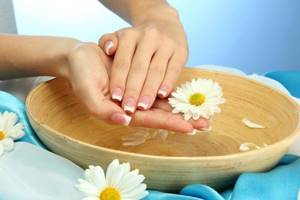
Advertisement
What cosmetics will help take care of your skin after childbirth?
As for the skin, after childbirth women most often complain about its sagging and the presence of stretch marks. Unfortunately, it is impossible to completely get rid of stretch marks using cosmetics alone. Plastic surgery methods are the most effective in the fight against stretch marks. But you can make stretch marks less noticeable and your skin more elastic. Anti-stretch mark cream and oil will help with this. When choosing them, you need to make sure that they contain vitamins A or E.
We must not forget about the skin of the chest, because it inevitably stretches. You also need to take care of the skin of your breasts using special products, most often oils. Some of them not only make the skin elastic, but also promote milk production and also prevent mastitis.
Using cosmetics after childbirth will shorten the recovery period, so you shouldn’t neglect it!
Yulia Romanenko
